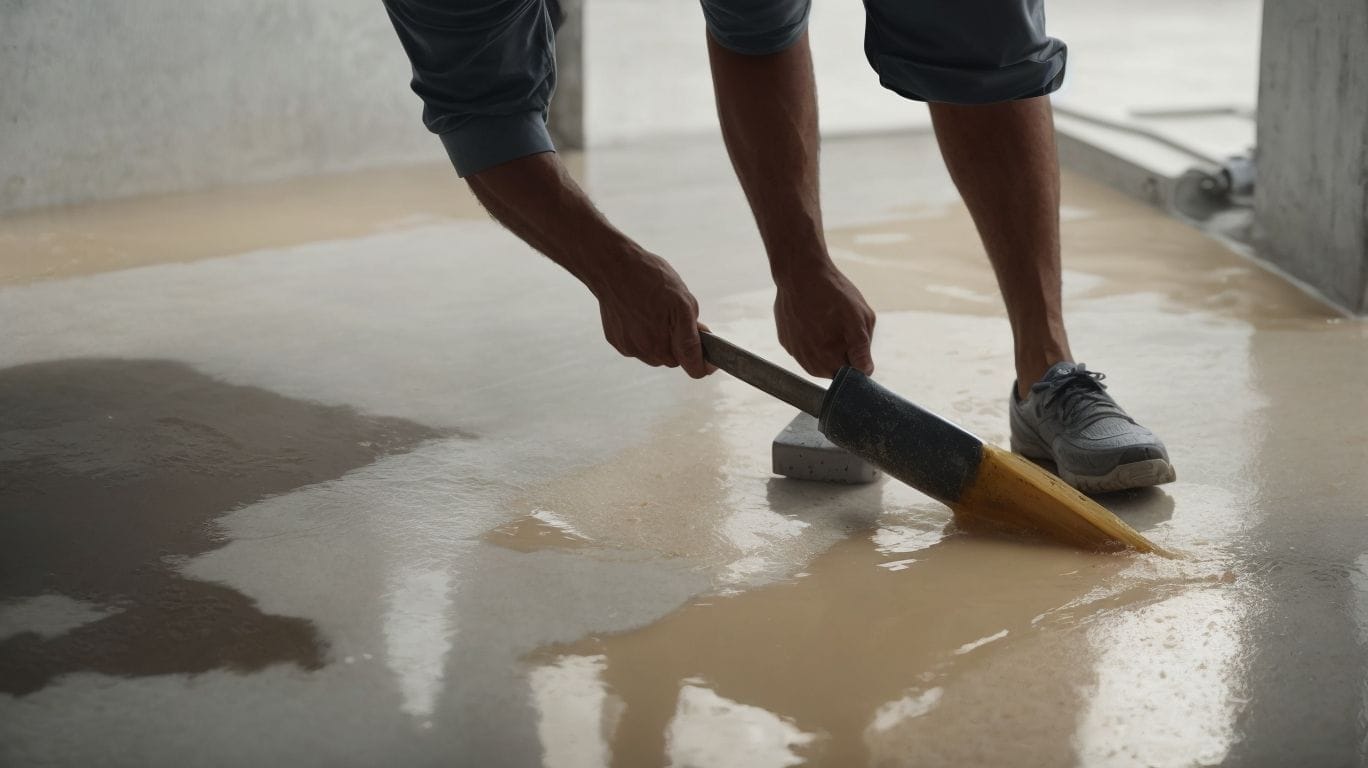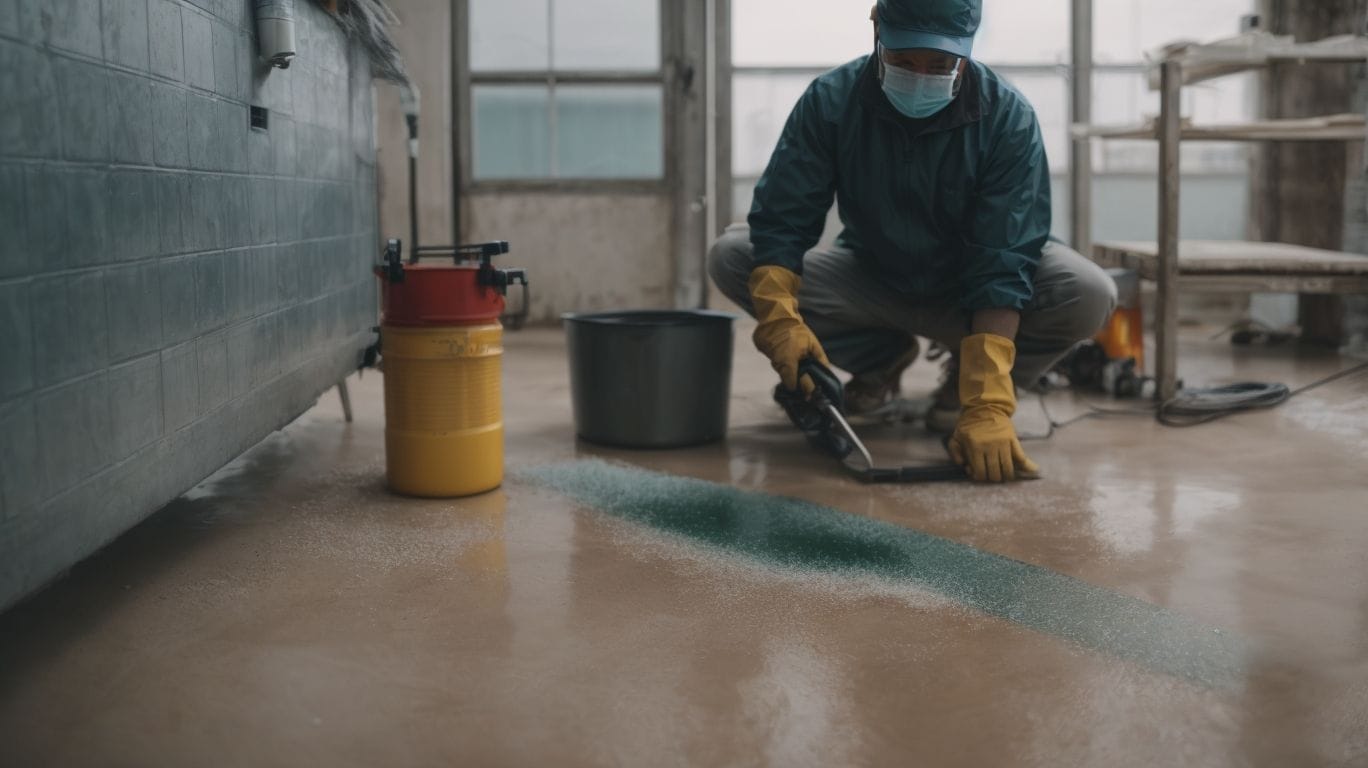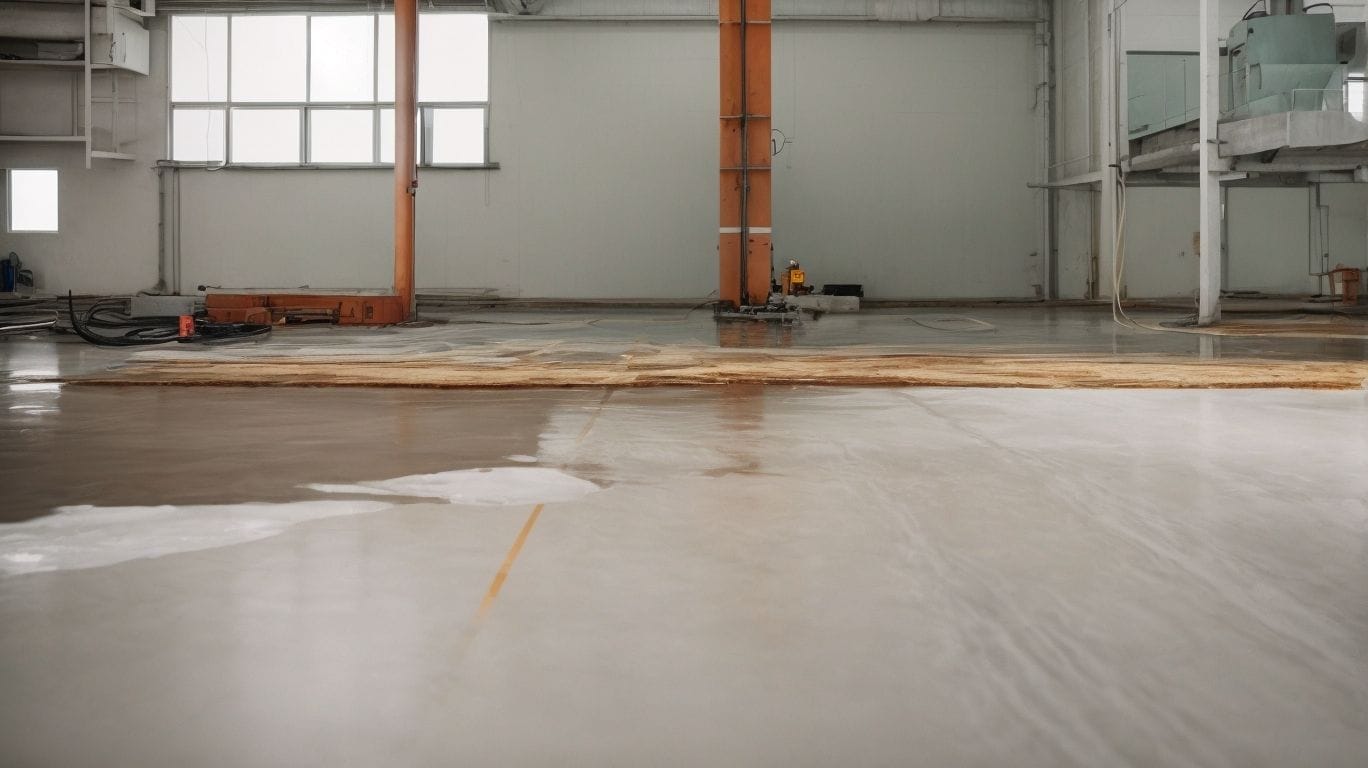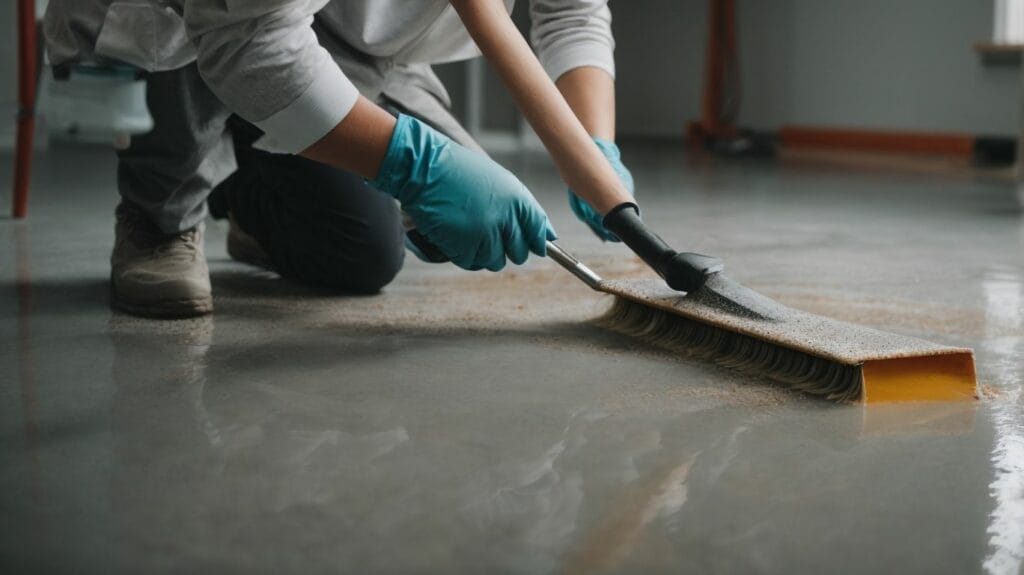Epoxy flooring is a durable and popular flooring option made from a two-part mixture of resin and hardener. It is typically used in high-traffic areas like garages, warehouses, and industrial settings due to its strength and resistance to chemicals and heavy objects. However, there may come a time when one needs to remove epoxy flooring. Whether it’s due to damage, a change in aesthetic preference, or the need for a different type of flooring, the process can be daunting.
There are various tools and materials necessary for removing epoxy flooring, such as:
- a floor scraper
- heat gun
- chemical strippers
- and a diamond-grinding tool
A study by the Journal of Cleaner Production reveals that using diamond grinding tools results in less waste and lower energy consumption compared to other methods.
The process of removing epoxy flooring involves:
- preparing the area
- using a heat gun to soften the epoxy
- scraping off the softened epoxy
- and using chemical strippers and a diamond grinding tool to grind off any remaining epoxy
It is essential to take safety precautions when removing epoxy flooring, such as:
- wearing protective gear
- working in a well-ventilated area
- and following the manufacturer’s instructions for chemical strippers
Removing epoxy flooring can be a challenging task, but with the right tools and precautions, it can be done effectively. It is always advisable to consult a professional for larger areas or if you are unsure of the process.
Key Takeaways:
- Epoxy flooring can be removed using tools such as a floor scraper, heat gun, chemical strippers, and a diamond grinding tool.
- Reasons for removing epoxy flooring include damage, change in aesthetic preference, or the need for a different type of flooring.
- When removing epoxy flooring, it is important to take safety precautions by wearing protective gear, working in a well-ventilated area, and following the manufacturer’s instructions for chemical strippers.
What Is Epoxy Flooring?

Photo Credits: Diyepoxyresin.Com by Kyle Ramirez
Epoxy flooring is a type of floor coating that is created by combining a resin with a hardener. This results in a strong and long-lasting material that adheres well to concrete, making it a popular choice for industrial and commercial spaces.
Fun Fact: Due to its durability, epoxy flooring is often used in areas with heavy foot traffic, such as garages, warehouses, and manufacturing plants.
Why Would Someone Want to Remove Epoxy Flooring?

Photo Credits: Diyepoxyresin.Com by Aaron Hernandez
Epoxy flooring has become a popular choice for its durability and sleek appearance. However, there are instances where one may need to remove this type of flooring. In this section, we will explore the various reasons why someone would want to remove epoxy flooring. From damaged flooring to a change in aesthetic preferences, multiple factors may lead to this decision. We will also discuss the need for a different flooring type and how it may prompt the removal of epoxy flooring.
1. Damaged Flooring
- Evaluate the level of damage to the epoxy flooring.
- Determine the affected area and the severity of the damage.
- Gather the necessary tools and materials for repairing the damaged flooring.
- Remove any loose or chipped epoxy to assess the condition of the underlying concrete.
- Identify and address the underlying cause of the damage to prevent future issues.
In 1927, The Fairmont Hotel in San Francisco was the first building to utilize epoxy flooring, revolutionizing the construction industry with its durability and versatility.
2. Change in Aesthetic Preference
- Assess the Current Aesthetic: Evaluate the existing epoxy flooring to determine the desired changes in aesthetic preference.
- Research Alternative Aesthetics: Explore different flooring designs, colors, and textures to identify the preferred aesthetic for the change.
- Consult with Professionals: Seek advice from flooring experts or interior designers to understand the feasibility of achieving the new aesthetic preference.
- Create a Removal Plan: Develop a step-by-step strategy for safely and effectively removing the current epoxy flooring to accommodate the desired change in aesthetic.
3. Need for Different Flooring Types
- Assess Flooring Needs: Evaluate if the current epoxy flooring meets functional and aesthetic requirements, taking into consideration the need for a different flooring type.
- Research Alternatives: Explore various flooring types like ceramic tiles, hardwood, or luxury vinyl to determine the best fit for the new usage as a home gym.
- Consider Long-Term Suitability: Anticipate future needs and durability to select a flooring type that aligns with long-term plans for the garage.
A friend wanted to replace their current epoxy flooring in their garage with durable interlocking tiles due to a shift in usage from a storage area to a home gym.
What Tools and Materials Are Needed to Remove Epoxy Flooring?

Photo Credits: Diyepoxyresin.Com by Dylan Harris
When it comes to removing epoxy flooring, having the right tools and materials is essential. In this section, we will discuss the necessary equipment for a successful removal process. From a sturdy floor scraper to a powerful heat gun, each tool serves a specific purpose in removing epoxy flooring. We will also touch on the use of chemical strippers and diamond grinding tools, as well as their pros and cons. By understanding the different options available, you can choose the best approach for your specific epoxy flooring removal needs.
1. Floor Scraper
- Inspect the epoxy flooring to identify damaged areas and the thickness of the epoxy layer.
- Position the floor scraper at a consistent angle and apply firm pressure to lift the epoxy coating off the concrete surface.
- Work methodically and cover the entire area, ensuring all the epoxy is removed.
- Dispose of the removed epoxy safely according to local regulations.
When using a floor scraper, make sure to maintain a consistent angle and pressure for effective removal without causing damage to the underlying surface.
2. Heat Gun
- Make sure to use a heat gun with a nozzle attachment to concentrate the heat on a specific area.
- Set the heat gun to a low to medium heat setting to avoid damaging the concrete or subfloor beneath the epoxy.
- Hold the heat gun 2-4 inches away from the epoxy surface and move it back and forth until the epoxy softens.
Pro-tip: Remember to keep the heat gun in motion to prevent overheating and to soften the epoxy evenly evenly.
3. Chemical Strippers
- Before starting, make sure to clear any obstacles and ensure proper ventilation in the area.
- Follow the manufacturer’s instructions and apply the chemical stripper, letting it sit and soften the epoxy.
- Using a floor scraper, evenly apply pressure to remove the softened epoxy for thorough removal.
- Dispose of the stripped epoxy material safely and in accordance with local regulations.
4. Diamond Grinding Tool
- Make sure to use a diamond grinding tool with specialized diamond segments designed specifically for removing epoxy.
- Properly adjust the speed and pressure of the tool to effectively grind off the epoxy without causing any damage to the underlying surface.
- After grinding, be sure to clean the area to remove any remaining epoxy residue thoroughly.
How to Remove Epoxy Flooring?

Photo Credits: Diyepoxyresin.Com by Daniel Adams
If you’re looking to remove epoxy flooring, you’ve come to the right place. This section will provide a step-by-step guide on how to remove epoxy flooring from your space effectively. From preparing the area to using specialized tools, we’ll cover all the necessary steps to ensure a successful removal process. By the end, you’ll have the knowledge and techniques to remove epoxy flooring with ease and efficiency. Let’s get started.
1. Prepare the Area
When getting ready to remove epoxy flooring, it is important to take your time and ensure a clean and safe working environment. If the area is extensive or presents any challenges, consider seeking the assistance of a professional.
- Begin by clearing the area of any furniture, objects, or obstructions.
- Make sure to open windows and doors for proper ventilation.
- Use plastic sheeting to cover outlets, vents, and doorways to prevent dust or debris from spreading.
- Before starting the epoxy removal process, carefully inspect the area for any cracks or damages that may require repair.
2. Use a Heat Gun to Soften epoxy
Before beginning, make sure to clear the work area of any obstacles and ensure proper ventilation.
Start by plugging in the heat gun and allowing it to reach the appropriate temperature for softening the epoxy.
Once the heat gun is ready, hold it 6-8 inches away from the epoxy surface and move it in a consistent motion to soften the epoxy evenly evenly.
Using a putty knife or floor scraper, gently lift the softened epoxy from the surface.
Repeat the process as necessary until the desired amount of epoxy is removed.
When using a heat gun to soften epoxy, it is important to maintain a safe distance from the surface and follow all safety precautions to avoid accidents or damage.
3. Scrape Off Epoxy
- Begin the process of removing the epoxy flooring by using a floor scraper.
- Work methodically, carefully scraping off the epoxy layer by layer until the entire floor is cleared.
- Properly dispose of the scraped epoxy according to local regulations.
4. Use Chemical Strippers
- Apply the chemical stripper: Apply the chemical stripper over the epoxy surface using a brush or roller.
- Allow dwell time: Let the chemical stripper sit on the epoxy according to the manufacturer’s instructions to soften the coating.
- Scrape off softened epoxy: Use a floor scraper to remove the softened epoxy, ensuring the following safety precautions.
- Clean the area: Thoroughly clean the area to ensure all remnants of the epoxy and chemical stripper are removed.
5. Grind Off Epoxy with Diamond Grinding Tool
- Prepare the area by removing any obstacles and ensuring a clear workspace.
- Use the diamond grinding tool to grind off the epoxy, starting from one corner and working methodically across the entire surface.
- Ensure proper safety precautions, including wearing protective gear and working in a well-ventilated area.
What Are the Safety Precautions When Removing Epoxy Flooring?

Photo Credits: Diyepoxyresin.Com by Mason Taylor
When it comes to removing epoxy flooring, safety should always be a top priority. Several hazards can arise during the removal process, such as exposure to chemicals and potential injuries from tools and materials. In this section, we will discuss the essential safety precautions to take when removing epoxy flooring. These include wearing appropriate protective gear, working in a well-ventilated area, and following the manufacturer’s instructions when using chemical strippers. By following these precautions, you can ensure a safe and successful removal process.
1. Wear Protective Gear
- Wear long-sleeved clothing to protect your arms from chemicals and abrasions.
- Use gloves to shield your hands from chemical exposure and potential injuries during the removal process.
- Wear a respirator mask to prevent inhalation of harmful fumes and dust particles.
- Protect your eyes with safety goggles to avoid eye irritation or injuries from debris.
- Wear sturdy work boots to safeguard your feet from hazards such as falling objects or sharp materials.
In 1853, protective gear became a common sight in industrial workplaces. Thanks to the introduction of the first industrial respirator by Alexander von Humboldt, workers were able to handle hazardous working conditions more safely and effectively.
2. Work in a Well-Ventilated Area
- Prioritize Ventilation: Ensure adequate airflow by opening windows or using fans.
- Use Respiratory Protection: Wear a mask to prevent inhaling fumes or particles.
- Avoid Confined Spaces: Work in a well-ventilated area, such as an open or well-ventilated space, to minimize exposure.
Suggestions: Consider using exhaust fans for improved ventilation. Always prioritize personal safety when working with chemicals or tools.
3. Follow the Manufacturer’s Instructions for Chemical Strippers
- Follow the manufacturer’s instructions carefully to understand the application and safety measures for using chemical strippers.
- Ensure proper ventilation as per the instructions while working with chemical strippers.
- Wear recommended protective gear such as gloves, goggles, and masks as per the manufacturer’s guidelines.
- Adhere to the specified temperature and humidity conditions for optimal performance of chemical strippers.
In the 19th century, the first synthetic paint, a rubber-based product, was developed by Charles Goodyear, revolutionizing the coating industry.
Summary

Photo Credits: Diyepoxyresin.Com by Randy Torres
When removing epoxy flooring, it is important to consider using either chemical solvents or mechanical methods such as grinding or sanding. Safety should always be a priority, so be sure to wear protective gear and ensure proper ventilation. Once the process is complete, thoroughly clean the area to remove any residue.
In the 1920s, the true history of epoxy resins began when German scientist Dr. Pierre Castan discovered the chemical reaction between Bisphenol-A and Epichlorohydrin, resulting in the creation of epoxy resin.


